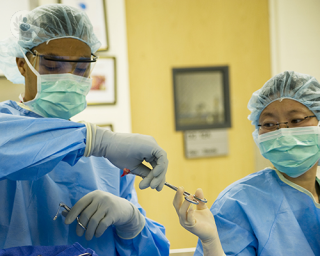Hiatal hernia
Professor Sanjay Purkayastha - Surgery
Created on: 10-21-2015
Updated on: 04-26-2023
Edited by: Conor Lynch
What is a hiatal hernia?
A hiatal hernia is when the stomach bulges up into the chest via an opening in the diaphragm, a large, thin sheet of muscle separating the chest and abdomen.

What are the different types of hiatal hernia?
There are two types of hiatal hernia; sliding and para-oesophageal.
- Sliding hiatal hernias
- They move up and down and in and out of the chest area. They are the most common type of hernia and more than 80 per cent of hiatus hernias are this type.
- Para-oesophageal hiatus hernias
- These are also known as rolling hiatus hernias. They occur when part of the stomach pushes through the hole in the diaphragm next to the oesophagus. They are less common, and around 5 to fifteen per cent of hiatus hernias are para-oesophageal.
What are the symptoms of a hiatal hernia?
The symptoms of a hiatal hernia include:
- Heartburn, often after eating (GERD)
- Chest pain
- Bloating
- Trouble swallowing
- Upset stomach
- Shortness of breath
What causes a hiatal hernia?
It is not known what causes a hiatal hernia, but it is more common in those over the age of 50, overweight, and in pregnant women.
It may be the result of the diaphragm becoming weak over time, or pressure on the abdomen. Also, it can sometimes occur in newborn babies if there is a congenital defect of the stomach or diaphragm, where is isn't developed properly.

How are hiatal hernias diagnosed?
- Gastroscopy
- A gastroscope is used to examine the inside of your body and identify any issues. It sends images taken by a video camera at the end of it to an external monitor. It will be inserted into your mouth and down your throat, and the procedure may be carried out using local anaesthetic.
- X-ray
- A barium meal X-ray or barium swallow test, can be done to identify a hiatus hernia. The patient has to drink some barium solution, which is a non-toxic chemical that shows up clearly on an X-ray. After the barium moves down into your digestive system, X-rays will be taken. Your stomach and duodenum (the top of the small intestine) need to be empty so you won't be able to eat or drink anything for at least six hours before the procedure, and you may be given an injection to relax the muscles of your digestive system. The procedure usually takes about 15 minutes, and while you'll be able to eat and drink as normal afterwards you may need to drink more water in order to flush the barium out. It also may cause constipation and slight nausea, while your stools may be white for a few days afterwards.
What home remedies can help hiatal hernias?
Some lifestyle changes can help with a hiatal hernia, such as changing your eating habits to smaller meals, more often. It is important to avoid acidic foods and limit fatty foods and caffeine.
Other helpful lifestyle changes including giving up smoking, regularly exercising, and opting not to wear tight clothing or belts by choosing loose-fitting clothes. Your local pharmacist can give you over-the-counter medication to help with symptoms of GORD.

Is there is difference between small and large hiatal hernias?
Small hiatal hernias may not be felt at all. However, if they are large, they could force the opening in your diaphragm to become larger, too.
However, both small and large hiatal hernias don't require surgery if they are asymptomatic.
How are hiatal hernias treated?
Lifestyle changes and medication are the preferred treatments for hiatal hernia and treatment is only necessary if it's causing problems. Surgery may be used as an alternative to long-term medication, or if other treatments are ineffective.
Medication
There are various medications which can be used to treat hiatus hernia symptoms, which include:
- Antacids
- Alginates
- H2-receptor antagonists
- Proton-pump inhibitors (PPIs)
Laparoscopic (keyhole) surgery, or more specifically laparoscopic nissen fundoplication (LNF), is one of the most common surgical technique used to treat sliding hiatal hiatus hernias and GORD.
It involves small cuts being made into the stomach whilst you are under general anaesthetic, while carbon dioxide is used to inflate your abdomen to give the surgeon room to work. During the LNF procedure, the stomach is put back into the correct position and the diaphragm around the lower part of the oesophagus is tightened. This should prevent any acid moving out of your stomach. The surgery usually takes around 60 to 90 minutes.
Which specialist treats, repairs or fixes hiatal hernias?
A gastroenterologist diagnoses and treats hiatal hernias. For example, they undertake gastroscopies to investigate whether someone has a hiatal hernia.
A colorectal surgeon, who practice both general surgery and colorectal surgery undertakes hernia surgery.
















